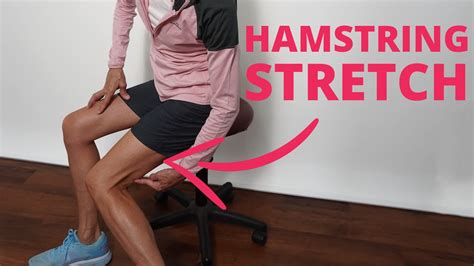Conquer Hamstring Pain: The Sitting Secret
Hamstring pain. That nagging tightness, the sharp twinge during a simple bend, the persistent ache that limits your mobility. It's a common complaint, affecting people of all ages and activity levels. While intense workouts and strenuous activities are often blamed, a surprising culprit often goes unnoticed: prolonged sitting. This article delves into the connection between sitting and hamstring pain, offering strategies to alleviate discomfort and prevent future issues.
Why Does Sitting Cause Hamstring Pain?
Prolonged sitting shortens the hip flexors – the muscles at the front of your hips. These muscles are antagonists to your hamstrings, meaning they work in opposition. When your hip flexors are tight, they pull your pelvis forward into an anterior tilt. This posture forces your hamstrings into a constantly shortened position, leading to:
- Reduced blood flow: Constricted muscles receive less oxygen and nutrients, hindering their ability to repair and function optimally.
- Muscle imbalances: The constant shortening weakens the hamstrings, making them more susceptible to injury.
- Increased tension: The shortened position creates tension and tightness, leading to pain and discomfort.
- Nerve compression: In some cases, tight hamstrings can compress sciatic nerves, radiating pain down the leg.
How Long is Too Long When Sitting?
There's no magic number, but prolonged sitting, generally considered anything over 3-4 hours without breaks, significantly increases the risk of hamstring tightness and pain. The cumulative effect of many hours of sitting throughout the day is far more impactful than one extended period.
What Are the Symptoms of Hamstring Pain Caused by Sitting?
Symptoms can vary in intensity and location, but common signs of hamstring pain related to prolonged sitting include:
- Tightness or stiffness: Feeling a pulling sensation in the back of the thigh, particularly after sitting for extended periods.
- Aching pain: A dull, persistent ache in the hamstring muscles.
- Sharp pain: A sudden, sharp pain when bending or stretching the leg.
- Limited range of motion: Difficulty bending your knee or straightening your leg fully.
- Pain during activities: Discomfort when walking, running, climbing stairs, or participating in sports.
How Can I Relieve Hamstring Pain From Sitting?
Addressing hamstring pain caused by sitting requires a multifaceted approach:
1. Regular Movement and Stretching:
This is crucial. Get up and move around every 30-60 minutes. Even short walks or simple stretches can make a significant difference. Focus on stretches specifically targeting the hamstrings, hip flexors, and glutes. Examples include:
- Standing hamstring stretch: Stand with feet hip-width apart, extend one leg slightly back, and bend at the hip, keeping your back straight.
- Seated hamstring stretch: Sit with legs extended and reach towards your toes.
- Pigeon pose (yoga): This targets both hip flexors and glutes.
- Knee-to-chest stretch: Lie on your back and pull one knee towards your chest.
2. Improve Your Posture:
Maintain good posture while sitting. Sit upright with your back straight, feet flat on the floor, and hips slightly higher than your knees. Consider using a lumbar support cushion to maintain the natural curve of your spine.
3. Strengthen Your Core:
Strong core muscles support proper posture and reduce strain on your hamstrings. Incorporate exercises like planks, bridges, and crunches into your routine.
4. Ergonomic Workstation:
Adjust your chair height, monitor placement, and keyboard position to promote good posture and reduce strain.
5. Consider Professional Help:
If pain persists or worsens, consult a physical therapist or doctor. They can provide a tailored exercise plan, address any underlying medical conditions, and recommend other treatment options, such as massage therapy or manual therapy.
Can I Prevent Hamstring Pain From Sitting?
Yes! Proactive measures can significantly reduce your risk:
- Regular exercise: Incorporate regular cardiovascular activity and strength training into your routine.
- Prioritize movement breaks: Set reminders to get up and move at regular intervals.
- Maintain good posture: Be mindful of your posture throughout the day.
- Stretch regularly: Make stretching a daily habit.
- Hydrate adequately: Dehydration can contribute to muscle tightness.
Frequently Asked Questions (FAQ)
What are the best stretches for hamstring pain caused by sitting?
The best stretches are those that target both the hamstrings and hip flexors. This includes standing hamstring stretches, seated hamstring stretches, pigeon pose, and knee-to-chest stretches. Remember to hold each stretch for 30 seconds and repeat several times.
How often should I stretch my hamstrings to prevent pain?
Aim to stretch your hamstrings at least once a day, ideally after prolonged sitting or before and after exercise.
Can sitting too much cause sciatica?
Yes, prolonged sitting can contribute to sciatica by compressing the sciatic nerve, which runs through the buttocks and down the legs. Tight hamstrings can exacerbate this compression.
What are some exercises to strengthen my hamstrings?
Hamstring curls (using resistance bands or weights), glute bridges, and deadlifts are effective exercises for strengthening your hamstrings. Start with lighter weights or resistance and gradually increase as you get stronger.
By understanding the link between prolonged sitting and hamstring pain, and by implementing the strategies outlined above, you can take control of your comfort and significantly reduce your risk of future problems. Remember, consistent effort is key to conquering hamstring pain and maintaining long-term mobility.

